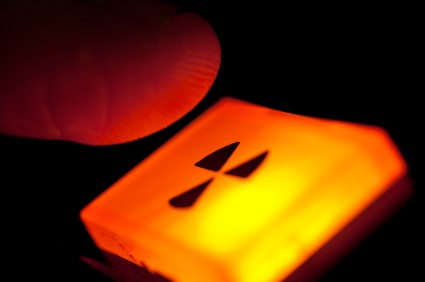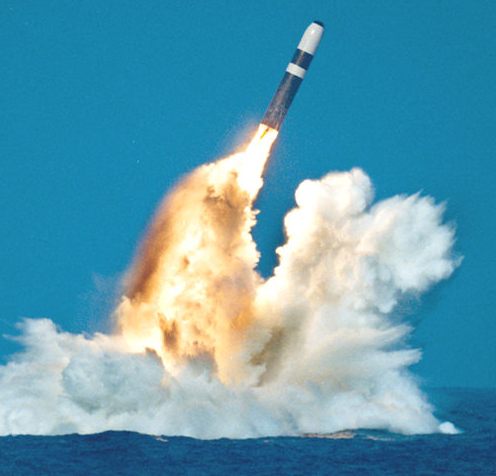Steven Starr on the overwhelming urgency of de-alerting U.S. & Russian missiles
Listen Now Download the show by right-clicking the link.
Steven Starr
In this episode of If You Love This Planet, Steven Starr talks about the continuing risk of accidental global nuclear war, how even a small number of nuclear explosions would cause irreparable harm to the climate, and the “20th Century mindset” behind the current debate about nuclear weapons. Starr is an Associate Member of the Nuclear Age Peace Foundation, a Senior Scientist with Physicians for Social Responsibility, and the Director of the Clinical Laboratory Science Program at the University of Missouri. Starr’s writings have been published by the Bulletin of the Atomic Scientists, and many reputable Web sites about nuclear weapons proliferation and environmental responsibility. Visit Starr’s Web site Nuclear Darkness, Global Climate Change and Nuclear Famine: The Deadly Consequences of Nuclear War. As background, read two articles by Starr, Eliminate Launch on Warning and High-alert nuclear weapons: the forgotten danger, both relevant to President Obama breaking his promise to take nuclear weapons off hair-trigger alert.
At the beginning of this interview which is essential to understanding the present risk of nuclear war, Dr. Caldicott asks Starr what inspired his work against nuclear weapons. He talks about his memories of the Cuban Missile Crisis in 1962, when he was 10, and how the American public was more aware of and concerned about the threat of nuclear war at that time. In college, he first studied nuclear engineering but then turned to biology after learning low radiation harms all life. Starr mentions Colonel Valery Yarynich, who was in charge of some Russian missiles during the Crisis but who now spearheads efforts by de-alert and disarm nuclear weapons. Read a 2007 article by Starr and Col. Yarynich, “Nuclear Primacy” is a Fallacy.

Starr points to the hair-trigger alert status of today’s U.S. and Russian nuclear weapons, and says we would not be alive today if the missiles were on the same status during the 1962 Crisis. Dr. Caldicott shares what Robert McNamara confided to her about the Crisis. She asks Starr if the nuclear engineers Starr studied under understood the consequences of their work. He talks about the deliberate attempt to prevent students from thinking about the ramifications of nuclear technology. Dr. Caldicott asks how many hydrogen bombs are on hair-trigger alert in the U.S. and Russia and what this alert status means to the world. Starr explains the types of U.S. and Russian warheads, their incredible explosive power and how quickly they can be launched. Dr. Caldicott points out how most cities and large towns in the U.S. and Europe are targeted with nuclear weapons. Starr describes the effect of a Russian hydrogen bomb detonating over Washington, D.C. Dr. Caldicott underlines how during a nuclear war, several bombs would detonate simultaneously on major cities like Washington and their effects would be exponentially increased. Starr refers to the classic book The Effects of Nuclear Weapons.
Starr and Dr. Caldicott look at the nuclear footballs the American and Russian presidents would use to program a nuclear attack, the command centers that would facilitate the launch order, and how the weakened Russian radar systems greatly increases the likelihood of nuclear war. They examine how alarmingly close the world came to nuclear annihilation in 1995. Dr. Caldicott encourages listeners to ponder why 20 years after the Cold War officially ended, the U.S. and Russia maintain enough nuclear weapons to destroy planet many times over (and these weapons could easily be launched by accident or terrorist activity). She asks Starr how false alarms occur in the nuclear war computer system. He provides examples of some close calls, and says they occur far more frequently than the public knows. Starr and Dr. Caldicott also explore how cyberwarfare and hacking of the Pentagon’s early-warning system could induce nuclear war in times of international tension. Starr discusses his efforts in collaboration with other countries to eliminate high-alert, quick-launch nuclear weapons, which represent “the ultimate accident waiting to happen.” He describes how it is “politically incorrect” to talk about the dangers of U.S. nuclear weapons, and how some Americans believe the U.S. nuclear arsenal “keeps the peace”. But Starr clarifies how “a single failure of deterrence can essentially kill everyone on the planet.”

A Trident missile launch. One U.S. Trident submarine holds enough nuclear missiles to destroy an entire continent. (solarnavigator.net)
Dr. Caldicott moves the conversation to the targeting system for nuclear war. Starr covers the submarines carrying nuclear weaponry, the explosive power of the weapons which would be used in a nuclear war compared to the arms used in World War II, and the firestorms and nuclear winter that would result from atomic warfare. Listen to Dr. Caldicott’s interview with nuclear war fire-damage expert Lynn Eden. He spells out how new studies on nuclear winter find that a much smaller number of nuclear explosions would cause the phenomenon. He says that www.nucleardarkness.org has many graphics illustrating the environmental effects of nuclear war. Starr then reveals some startling data about what would happen globally if India and Pakistan were to engage in a nuclear war, and what detonating even one percent of the U.S. and Russia arsenals would do to the Earth’s climate. Starr then responds to
Dr. Caldicott’s question about whether leaders in India and Pakistan, and in the U.S., understand the catastrophic hazards of nuclear weapons. In his reply, Starr talks about his encounters with a high-ranking U.S. officials who often know little about the effects of nuclear weapons.
Next, Dr. Caldicott asks about the aberrant thinking among the military and politicians who plan nuclear weapons policies in the U.S. Starr says there is a “World War II mindset” among these people, and he underlines the much higher explosive power of today’s nuclear weapons. He talks about why Russia is fearful of U.S. military moves on the Russian border, and his particular concern about NATO brinkmanship which has not been restrained in any way by President Obama. He describes how the best science has been used to develop accurate new data about nuclear war and nuclear winter, yet “true believers” in government positions refuse to discuss the consequences of nuclear warfare. Be sure to read Dr. Caldicott’s book The New Nuclear Danger: George W. Bush’s Military-Industrial Complex to understand the power of weapons companies, military officials and right-wing strategists in determining government policy. Starr and Dr. Caldicott discuss how the present Gulf oil spill exemplifies how a powerful industry may avoid looking at the potential ramifications of their work. Starr says the oil industry “assumed it would never happen. They never imagined the consequences.” He says that using the nuclear arsenals would be a “massive extinction event.” Dr. Caldicott says she is baffled by how there is now intense discussion about global warming, but practically nothing is said about the very real potential of nuclear winter. Starr mentions the reliable nuclear winter models he uses from the Goddard Space Institute, which also models global warming. He refers to Senator Jon Kyl who wants to spend billions of dollars “rebuilding” the U.S. nuclear arsenal “to be safe.” Read the May 24 press release Kyl Wrong on Impact of U.S. Nuclear Policies. Starr says such politicians have no awareness of science and should not have positions of responsibility. Dr. Caldicott talks about what could be accomplished if she and Starr were to have 30-60 minutes alone with President Obama. She appeals to listeners who might have some connection with Obama for assistance in arranging such a meeting. She mentions her new organization, The Helen Caldicott Foundation for a Nuclear-Free Planet, and that the organization’s Web site, www.nuclearfreeplanet.org, has numerous nuclear articles and links. She and Starr discuss how to reach younger people whose awareness of world affairs may be fragmented if they don’t read newspapers or read books, but instead rely on electronic media to selectively deal with the world.
Starr emphasizes the need to work together to eliminate nuclear weapons, “a true threat to our existence” Dr. Caldicott points to the many successes of the 1980s antinuclear movement, which involved doctors educating millions of people about the medical effects of nuclear war. She says that today, however, the public wrongly believes the nuclear threat is over and nuclear weapons were eliminated. Watch the 1982 Academy Award-winning documentary If You Love This Planet which features Dr. Caldicott’s speech about nuclear war. Starr talks about politicians led holding the START treaty hostage to conditions that specify building thousands more nuclear weapons (negating the intention of the START treaty). All religions, Dr. Caldicott says, should now prioritize “saving creation.”
For more information, visit Starr’s Web page nucleardarkness.org. Listen to Dr. Caldicott’s interviews with military analyst and former launch officer Bruce Blair and with nuclear-winter expert Dr. Alan Robock. Read
Dr. Caldicott’s articles Obama, Nuclear Weapons and the Future of the Planet and How Did an Idealistic President Become a Champion of Nuclear Power and By Default, Weapons Proliferation? Also read Fidel Castro’s July 11 article The Source of Wars: “Today, everything hangs by a thread”…. An incident could set in motion an all out nuclear war, and check out America’s Imperial Design. Prompt Global Strike: World Military Superiority Without Nuclear Weapons, Russian Colonel Who Averted Nuclear War Receives World Citizen Award, Inside the Apocalyptic Soviet Doomsday Machine, No Nukes, No Empire: The Abolition of Nuclear Weapons Requires the End of the U.S. Empire, What’s Next for the Nuclear Disarmament Movement?, The New Anti-Nuclear Movement, Mr President, Building Up the Nuclear Weapons Complex Is NOT Nuclear Disarmament, ‘Peace Prize’ President Submits Largest War Budget Ever, and Obama and the Works of Death. Read the reports Whole World on Fire: Organizations, Knowledge, and Nuclear Weapons Devastation: How and why war planners underestimated the damage caused by nuclear weapons fire effects, Casualties and smoke emissions from regional and global nuclear conflict, Climate effects of a regional nuclear conflict, Nuclear winter revisited with a modern climate model and Current nuclear arsenals: Still catastrophic consequences, and Massive global ozone loss predicted following regional nuclear conflict. Visit the Web sites of Beyond Nuclear and the International Physicians for the Prevention of Nuclear War. See the briefing papers De-Alerting Nuclear Weapons: Stepping Back From the Brink and De-Alerting Nuclear Weapons: Frequently Asked Questions. Visit the Web site about the new film, Countdown to Zero, which opened in the U.S. on July 23. Listeners are urged to tell others to hear this episode.